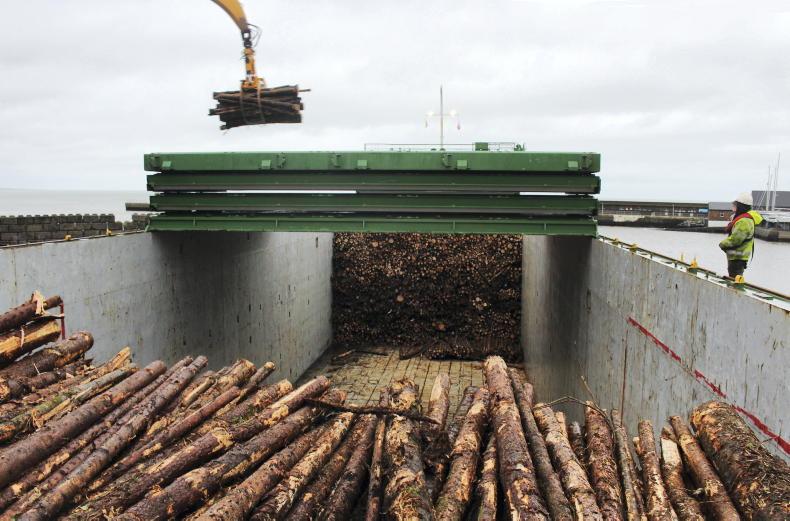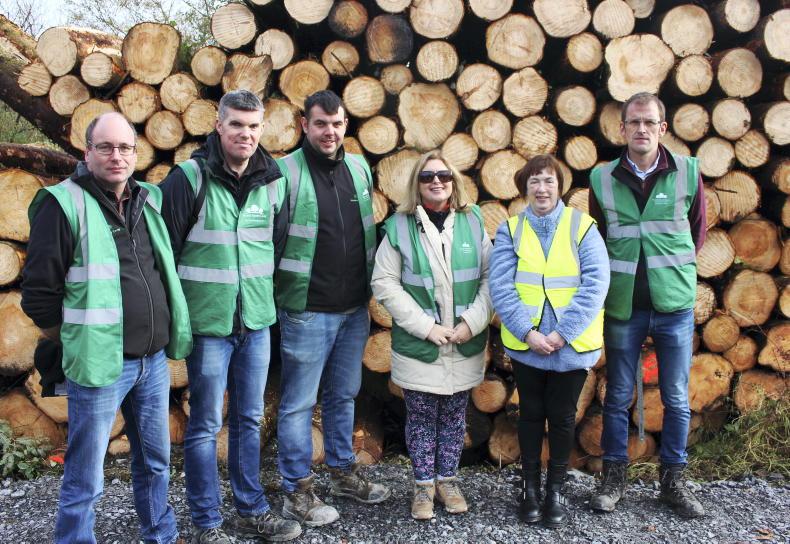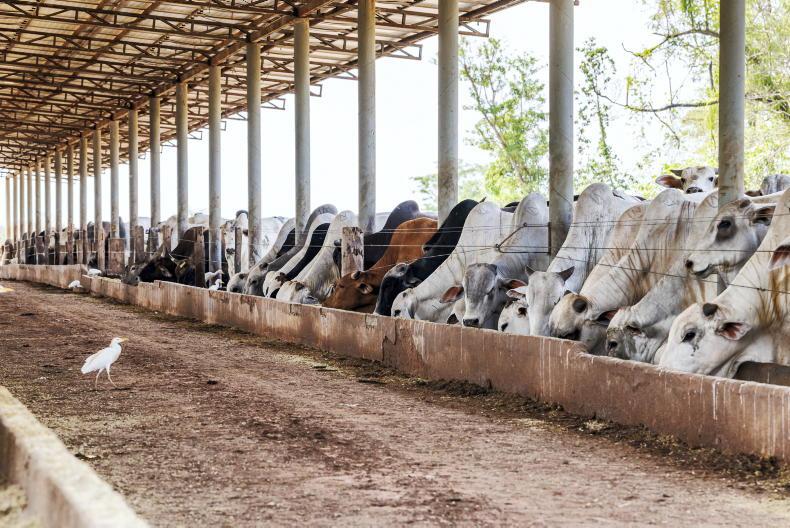By 2025, roundwood supply will reach 6 million m3, but this will fall short of requirements by up to 2.3 million m3 if sawmills and wood energy providers realise their potential, according to the COFORD report ‘Wood Supply and Demand on the Island of Ireland to 2030’.
Sawmills
Within two years, sawmills estimate that they will require 4.3 million m3 of logs, but the COFORD report projects 3.7 million m3 as being available (Table 1).
“This shortfall is likely to be met by imported certified roundwood for processing in Ireland,” it maintains.
Sawmills have relied on logs from Scotland for years, but if these forecasts are correct, they will need to more than double imports by 2035.
The performance of sawmills is vital for a successful forest industry, as the mills not only export up to 70% of their product, but 45% of all logs end up as wood residue (wood chips, sawdust and bark), which is an essential material for the wood energy and wood-based panel (WBP) industries.
Bark is an increasingly important niche horticultural market in the absence of peat production.
Wood energy
The COFORD report forecasts a shortfall of logs to supply the biomass wood energy sector, which could vary from 1.6 million m3 to 1.8 million m3 in 2025 depending on demand.
It acknowledges that there is “scope to sustainably increase the level of harvest over forecast”, but again accepts that “part of the supply deficit will be met by wood imports”.
Board mills
There are three WBP mills in Ireland – two Medite Smartply mills in Clonmel and Waterford, owned by Coillte and Masonite in Carrick-on-Shannon.
The supply of small logs and wood residue to the board mills specialising in WBP products is likely to meet demand.
Medite Smartply’s supply is guaranteed, because Coillte can ring fence pulpwood supply from their own forests while both Coillte and Masonite wood residue supply is healthy, because both companies have built up good trading relationships with their sawmill suppliers over the years.
Supply demand
While log demand is likely to outstrip supply, it may not be as large as the COFORD report outlines, according to some forestry companies. There may be more logs available, especially from private forest owners, estimated at 2.6 million m3 by 2025.
Because the private sector has had problems securing felling licences in recent years, there is likely to be a significant reserve of standing timber in forests that hasn’t been harvested. In addition, many private growers with felling licences may not have activated them yet, in the hope of getting better prices.
The COFORD report forecasts a shortfall of logs to supply the biomass wood energy sector, which could vary from 1.6 million m3 to 1.8 million m3 in 2025
While this is understandable in the case of clearfelling, there is no reason not to thin, as small logs are in demand both for energy and WBP products.
If demand forecasts are accurate, this will place pressure on sawmills to source competitively priced logs, but it “offers encouragement to those forest owners who will be bringing sawlog to market over the coming decade”, the COFORD report states.
Overall, the roundwood medium forecast is positive, as the annual potential log supply on the island is estimated to “increase from 4.7 million m3 in 2021 to 7.9 million m3 by 2035”, the COFORD forecast claims.
Beyond this, recent poor afforestation returns are likely to impact negatively on long-term log supply. For example, from 2035 to 2045, first- and second-thinning, and even some clearfells, will be harvested from annual coniferous afforestation carried out during the period 2010 to 2022 – which fell from approximately 6,000ha to 1,400ha.
This illustrates the urgent need to increase afforestation programmes to viable levels.
Despite woodchip imports, pulpwood exports likely to continue
Ireland has been exporting pulpwood for decades.
It was thought that this would cease once the wood energy market ramped up production. Yet, as Lorcan Roche Kelly reported in last week’s Irish Farmers Journal, Bord na Móna has recently imported a shipment of woodchips from Brazil for its Edenderry Power biomass plant.
All this was taking place while woodchips and pulpwood logs were being exported from four Irish ports to supply wood energy and WBP markets in the UK.
A number of forestry companies and sawmills that sell logs to the domestic wood energy and WBP markets, claim that wood energy market prices are too low at present.
I recently met Jim Hurley and Jordan Foxton from Euroforest Ireland at Wicklow Port, where a shipment of 2,700t of pulpwood was finalised for export.
“The primary reason for developing an export market for pulpwood logs is to maximise the return to our clients –mainly farmers – who are thinning their plantations,” said Hurley, as a steady flow of lorries arrived with logs sourced in Wicklow and neighbouring counties.
“We exported 100,000t of pulpwood in 2022 to the UK and we will increase this significantly over the coming years,” he said.

Jim Hurley and Jordan Foxton, Euroforest Ireland, at Wicklow Port where a 2,700t shipment of pulpwood is being loaded for export to the UK.
“Our clients are at the stage of forest management where their harvest has a high percentage of pulpwood, so it is critical that we maximise the return from this low-value log category,” said Jordan Foxton.
Hurley is not as pessimistic about the scale of imports required as outlined in the COFORD report.
“While felling licences have improved, there is plenty of material available but still waiting for licence approvals,” he said, but acknowledged that the sector “needs more investment in harvesting machinery to maximise volume output”.
Both agreed that there are major reserves of timber to satisfy the domestic market while maintaining robust exports.
“We need to export pulpwood in the future as we get closer to reaching the annual private harvest volume of 4.4 million m3 in 2035,” said Foxton.
“Exports are a major option and forest owners are attracted to this market, as we in Euroforest organise the logistics, including felling licences, harvesting, haulage and export documentation,” he said.
Both agreed that there are major reserves of timber to satisfy the domestic market while maintaining robust exports
Euroforest has also organised the strategic location of ports – Wicklow, Sligo, Cork and Limerick. “These are geographically close to our clients’ forests and allow us to access markets in England and up to Inverness in Scotland,” said Hurley.
Regarding the provision of materials to domestic energy outlets, Euroforest acknowledge this as a potential market – providing prices and contracts are sustainable.
Yet, as the steady convoy of lorries line up at Wicklow Port, pulpwood exports are likely to remain a major option to ensure a competitive forestry and forest products sector.
Bord na Móna will require 175,000t of logs and residue next year, which ideally should be available in Ireland. The company provides suppliers with a continuous year-round sustainable contract, but price is an issue.
Bord na Móna declined an invitation to comment on issues, such as pricing and supply of pulpwood material for its Edenderry Power biomass plant.
The theme for the upcoming Teagasc ‘Talking Timber’ event is ‘Planning towards sustainable timber production’.
Comprehensive information will be provided on current timber markets and advice on how to prepare and sell timber to achieve the best economic and environmental outcomes.
The event takes place at the Athlone Springs Hotel, Monksland, Athlone, Co Roscommon (N37 F9T3) on Tuesday 23 May (9:30am – 2:30pm).
The event is free, but registration is required. Google “Teagasc forestry” for further information.
By 2025, roundwood supply will reach 6 million m3, but this will fall short of requirements by up to 2.3 million m3 if sawmills and wood energy providers realise their potential, according to the COFORD report ‘Wood Supply and Demand on the Island of Ireland to 2030’.
Sawmills
Within two years, sawmills estimate that they will require 4.3 million m3 of logs, but the COFORD report projects 3.7 million m3 as being available (Table 1).
“This shortfall is likely to be met by imported certified roundwood for processing in Ireland,” it maintains.
Sawmills have relied on logs from Scotland for years, but if these forecasts are correct, they will need to more than double imports by 2035.
The performance of sawmills is vital for a successful forest industry, as the mills not only export up to 70% of their product, but 45% of all logs end up as wood residue (wood chips, sawdust and bark), which is an essential material for the wood energy and wood-based panel (WBP) industries.
Bark is an increasingly important niche horticultural market in the absence of peat production.
Wood energy
The COFORD report forecasts a shortfall of logs to supply the biomass wood energy sector, which could vary from 1.6 million m3 to 1.8 million m3 in 2025 depending on demand.
It acknowledges that there is “scope to sustainably increase the level of harvest over forecast”, but again accepts that “part of the supply deficit will be met by wood imports”.
Board mills
There are three WBP mills in Ireland – two Medite Smartply mills in Clonmel and Waterford, owned by Coillte and Masonite in Carrick-on-Shannon.
The supply of small logs and wood residue to the board mills specialising in WBP products is likely to meet demand.
Medite Smartply’s supply is guaranteed, because Coillte can ring fence pulpwood supply from their own forests while both Coillte and Masonite wood residue supply is healthy, because both companies have built up good trading relationships with their sawmill suppliers over the years.
Supply demand
While log demand is likely to outstrip supply, it may not be as large as the COFORD report outlines, according to some forestry companies. There may be more logs available, especially from private forest owners, estimated at 2.6 million m3 by 2025.
Because the private sector has had problems securing felling licences in recent years, there is likely to be a significant reserve of standing timber in forests that hasn’t been harvested. In addition, many private growers with felling licences may not have activated them yet, in the hope of getting better prices.
The COFORD report forecasts a shortfall of logs to supply the biomass wood energy sector, which could vary from 1.6 million m3 to 1.8 million m3 in 2025
While this is understandable in the case of clearfelling, there is no reason not to thin, as small logs are in demand both for energy and WBP products.
If demand forecasts are accurate, this will place pressure on sawmills to source competitively priced logs, but it “offers encouragement to those forest owners who will be bringing sawlog to market over the coming decade”, the COFORD report states.
Overall, the roundwood medium forecast is positive, as the annual potential log supply on the island is estimated to “increase from 4.7 million m3 in 2021 to 7.9 million m3 by 2035”, the COFORD forecast claims.
Beyond this, recent poor afforestation returns are likely to impact negatively on long-term log supply. For example, from 2035 to 2045, first- and second-thinning, and even some clearfells, will be harvested from annual coniferous afforestation carried out during the period 2010 to 2022 – which fell from approximately 6,000ha to 1,400ha.
This illustrates the urgent need to increase afforestation programmes to viable levels.
Despite woodchip imports, pulpwood exports likely to continue
Ireland has been exporting pulpwood for decades.
It was thought that this would cease once the wood energy market ramped up production. Yet, as Lorcan Roche Kelly reported in last week’s Irish Farmers Journal, Bord na Móna has recently imported a shipment of woodchips from Brazil for its Edenderry Power biomass plant.
All this was taking place while woodchips and pulpwood logs were being exported from four Irish ports to supply wood energy and WBP markets in the UK.
A number of forestry companies and sawmills that sell logs to the domestic wood energy and WBP markets, claim that wood energy market prices are too low at present.
I recently met Jim Hurley and Jordan Foxton from Euroforest Ireland at Wicklow Port, where a shipment of 2,700t of pulpwood was finalised for export.
“The primary reason for developing an export market for pulpwood logs is to maximise the return to our clients –mainly farmers – who are thinning their plantations,” said Hurley, as a steady flow of lorries arrived with logs sourced in Wicklow and neighbouring counties.
“We exported 100,000t of pulpwood in 2022 to the UK and we will increase this significantly over the coming years,” he said.

Jim Hurley and Jordan Foxton, Euroforest Ireland, at Wicklow Port where a 2,700t shipment of pulpwood is being loaded for export to the UK.
“Our clients are at the stage of forest management where their harvest has a high percentage of pulpwood, so it is critical that we maximise the return from this low-value log category,” said Jordan Foxton.
Hurley is not as pessimistic about the scale of imports required as outlined in the COFORD report.
“While felling licences have improved, there is plenty of material available but still waiting for licence approvals,” he said, but acknowledged that the sector “needs more investment in harvesting machinery to maximise volume output”.
Both agreed that there are major reserves of timber to satisfy the domestic market while maintaining robust exports.
“We need to export pulpwood in the future as we get closer to reaching the annual private harvest volume of 4.4 million m3 in 2035,” said Foxton.
“Exports are a major option and forest owners are attracted to this market, as we in Euroforest organise the logistics, including felling licences, harvesting, haulage and export documentation,” he said.
Both agreed that there are major reserves of timber to satisfy the domestic market while maintaining robust exports
Euroforest has also organised the strategic location of ports – Wicklow, Sligo, Cork and Limerick. “These are geographically close to our clients’ forests and allow us to access markets in England and up to Inverness in Scotland,” said Hurley.
Regarding the provision of materials to domestic energy outlets, Euroforest acknowledge this as a potential market – providing prices and contracts are sustainable.
Yet, as the steady convoy of lorries line up at Wicklow Port, pulpwood exports are likely to remain a major option to ensure a competitive forestry and forest products sector.
Bord na Móna will require 175,000t of logs and residue next year, which ideally should be available in Ireland. The company provides suppliers with a continuous year-round sustainable contract, but price is an issue.
Bord na Móna declined an invitation to comment on issues, such as pricing and supply of pulpwood material for its Edenderry Power biomass plant.
The theme for the upcoming Teagasc ‘Talking Timber’ event is ‘Planning towards sustainable timber production’.
Comprehensive information will be provided on current timber markets and advice on how to prepare and sell timber to achieve the best economic and environmental outcomes.
The event takes place at the Athlone Springs Hotel, Monksland, Athlone, Co Roscommon (N37 F9T3) on Tuesday 23 May (9:30am – 2:30pm).
The event is free, but registration is required. Google “Teagasc forestry” for further information.










SHARING OPTIONS